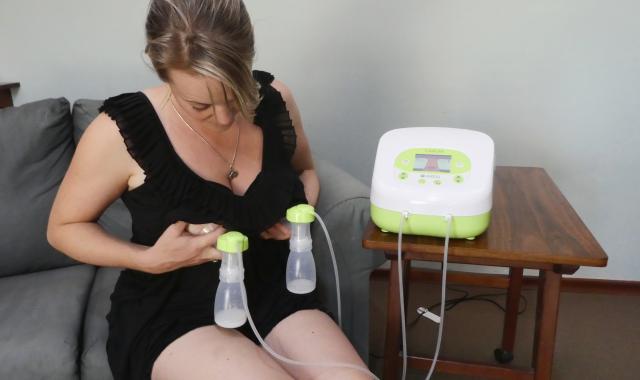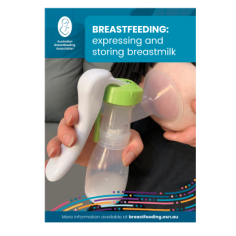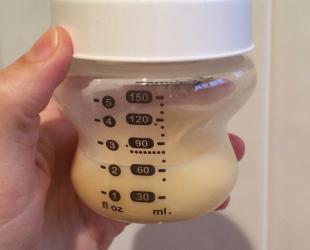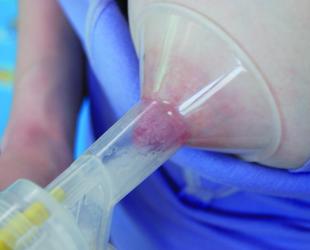If you decide to pump full time for your baby, here's how to make it work.

Choosing to exclusively express breastmilk, whether short or long term, can be a positive step for you and your baby. Some parents may find breastfeeding difficult or impossible due to medical, emotional, or practical reasons.
Whatever your situation, providing breastmilk is a wonderful gift, and support is available every step of the way.
Why you might choose exclusive expressing
- Your baby may be unable to feed well from the breast due to a physical or medical condition (e.g. cleft, heart problem, low tone, tongue-tie).
- You may face unresolved breast or nipple challenges.
- You may be separated from your baby.
- Feeding at the breast may feel emotionally challenging.
- You may feel uncomfortable feeding in public.
- You think expressing might be easier for your family.
No matter your reason, your determination to provide breastmilk deserves respect and support. Whether you pump or hand express, it’s extra work, so getting help is important. Skilled support may even help you overcome challenges and breastfeed directly.
Common questions about exclusive expressing.
A quality, hospital-grade double electric pump is best for long-term exclusive expressing. You can hire a pump from ABA or buy your own. Some mums use a smaller personal pump when out and a hospital-grade pump at home.
This may depend on the age of your baby and how much breastfeeding they've been doing up till now.
In the first few days, newborns take small amounts of colostrum each feed.1
Time | Intake (mL/feed) |
First 24 | 2-10 |
24-48 | 5-15 |
48-72 | 15-30 |
72-96 | 30-60 |
- If you’re still in the early weeks, you’ll need to express at least 8 times in 24 hours to mimic a baby’s feeding pattern.
- Exclusively breastfed babies aged 1 to 6 months drink an average of 750–800 mL in a 24-hour period (some need 500 mL, others 1000 mL+). So if you’re expressing to meet all your baby's needs, you’ll need to aim for this.
- The amount of milk babies take from feed to feed can vary, and the length of time at the breast doesn't always reflect the amount of milk taken. You may find it helpful to make up smaller bottles (e.g. about 60mL) and top your baby up with further small amounts as needed.
- As your baby starts solids, breastmilk needs may reduce, but it still remains their main source of nutrition for the first 12 months.
- The time it takes to express can vary depending on the time of the day, your pump and its settings, your technique and your milk flow.
- 15 minutes is common but you may need a little more or a little less.
- Continue for a few minutes after milk stops flowing to trigger another let-down.
- Pumping longer than 30 minutes is usually unnecessary.
Keeping up your supply
When you are exclusively expressing, you will be very aware of how much milk you are making, and you will notice even small changes in your supply. Here are some tips if you need to get more milk.
- Add extra expressing sessions over 24 hours.
- Expressing more often is more effective than longer sessions.
- Increase skin-to-skin time with your baby.
- Try a few short pumping sessions close together to mimic cluster feeding. Pump for 5–10 minutes at a time, repeating several times over an hour or two.
- Use a wearable pump for hands-free expressing.
- Try breast compressions and/or finish each session with hand expressing to remove more milk.
- Hands-on pumping can help increase milk over time. This is multi-step protocol that combines massage, compressions, and hand expression before, during, and after pumping.
If you still struggle with supply, talk to your doctor about medications that may help boost your supply. These don’t take the place of extra expressing; you will still need to pump often.
Feeding expressed breastmilk
If all your baby’s feeds are with expressed breastmilk, then bottles will probably be most convenient. If you want bottle-feeding to feel more like breastfeeding try some of the following:
Feed your baby based on their needs, watching for feeding cues rather than sticking to a schedule.
Use paced bottle-feeding which lets your baby control how much and how quickly they drink.
Alternate the side you hold your baby during feeds. This can help both sides of baby's vision and neck muscles to develop equally.
If you're providing your baby with expressed breastmilk temporarily and plan to establish breastfeeding, your baby may receive breastmilk via a feeding tube, supply line or even by cup.
Bonding with your baby
Bonding happens in many ways, not just through breastfeeding. Try some of the following:
- Skin-to-skin contact during feeding or anytime. This benefits your baby but also increases oxytocin which helps boost your supply.
- Holding or having your baby close while expressing.
- Feeding your baby in a ‘breastfeeding’ position, making eye contact and talking or singing to them.
- Wearing your baby in a carrier or sling.
- Sleeping close to your baby.
Providing breastmilk is a bonding gift in itself. If you’re expressing due to work or NICU separation, you’re maintaining a special connection.
The need for support
Exclusive expressers are dedicated and deserve respect and support. ABA is here for you, no matter how you feed your baby.
© Australian Breastfeeding Association December 2025
Read more about expressing and storing
Evidence-led info and practical tips from our Breastfeeding Information Series
Breastfeeding: expressing and storing breastmilk




